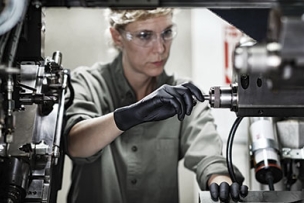Honeywell’s safety innovations protect the livelihoods of 500 million workers. With a legacy spanning over a century, Honeywell provides comprehensive PPE solutions from head-to-toe. Honeywell offers a vast of product solutions from brands you trust like Miller®, Uvex®, Howard Leight, North®, and Fibre-Metal®.
In the vast landscape of the utilities industry, where power generation, transmission, and distribution are vital, ensuring the safety of workers is paramount. Among the myriad risks they face, eye hazards stand out as particularly concerning. From high-voltage equipment to hazardous chemicals, the potential for eye injuries is ever-present.
Understanding the Risks
Within the utilities sector, workers encounter various hazards daily. These include:
- Electrical Hazards: Electricians and technicians working on power lines or within substations face the constant threat of electrical arcs and flashes, which can cause severe burns to the eyes.
- Mechanical Hazards: Machinery, equipment, and tools used in utility maintenance and construction can pose risks of impact, resulting in eye injuries from flying debris, particles, or tools.
- Chemical Hazards: Utility workers may come into contact with various chemicals, such as corrosive substances used in battery maintenance or cleaning agents for equipment, which can cause chemical burns or irritation to the eyes.
- Radiation Hazards: In certain utility operations, workers may be exposed to radiation, such as ultraviolet (UV) radiation from welding or infrared radiation from heat sources, leading to damage to the eyes if proper precautions are not taken.
Prevention and Mitigation Strategies
To safeguard against these hazards, utilities companies implement comprehensive safety protocols and provide workers with appropriate personal protective equipment (PPE).
Key strategies include:
- Training and Education: Proper training is essential to ensure workers understand the risks associated with their tasks and know how to mitigate them. This includes training on the use of PPE, safe work practices, and emergency procedures.
- Use of PPE: PPE, including safety glasses, goggles, face shields, and helmets with eye protection, plays a critical role in preventing eye injuries. These items should meet industry standards and be worn consistently when working in hazardous environments.
- Engineering Controls: Employers should implement engineering controls, such as machine guards, barriers, and ventilation systems, to minimize exposure to eye hazards where possible. Regular equipment maintenance and inspections are also crucial to identifying and addressing potential risks.
- Worksite Hazard Assessments: Conducting thorough hazard assessments allows companies to identify potential risks and implement appropriate control measures. This includes evaluating tasks, equipment, and environmental factors that could impact eye safety.
- Emergency Response Preparedness: In the event of an eye injury, prompt and effective first aid can prevent further damage. Utilities companies should have protocols in place for managing eye injuries, including access to eyewash stations and emergency medical treatment.
Promoting a Culture of Safety
Ultimately, creating a culture of safety within the utilities industry requires a collective effort from employers, workers, and regulatory bodies. By prioritizing eye safety through proper PPE, training, equipment provision, and proactive hazard management, utilities companies can significantly reduce the risk of eye injuries and ensure the well-being of their workforce.
In conclusion, while the utilities sector plays a vital role in powering communities, it also presents inherent risks to workers' eye safety. By understanding these risks, implementing effective prevention measures, and fostering a culture of safety, utilities companies can protect their most valuable asset–their employees' vision.
Previously Featured on Honeywell's blog.









Talk to Us!
Leave a reply
Your email address will not be published. Required fields are marked *